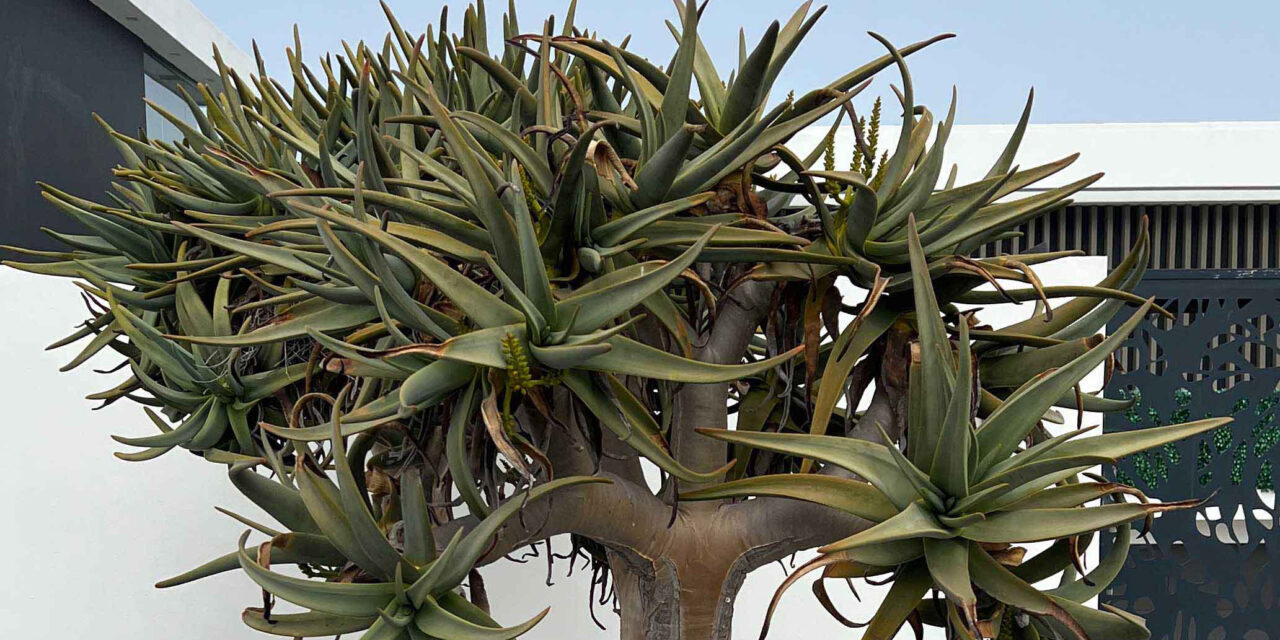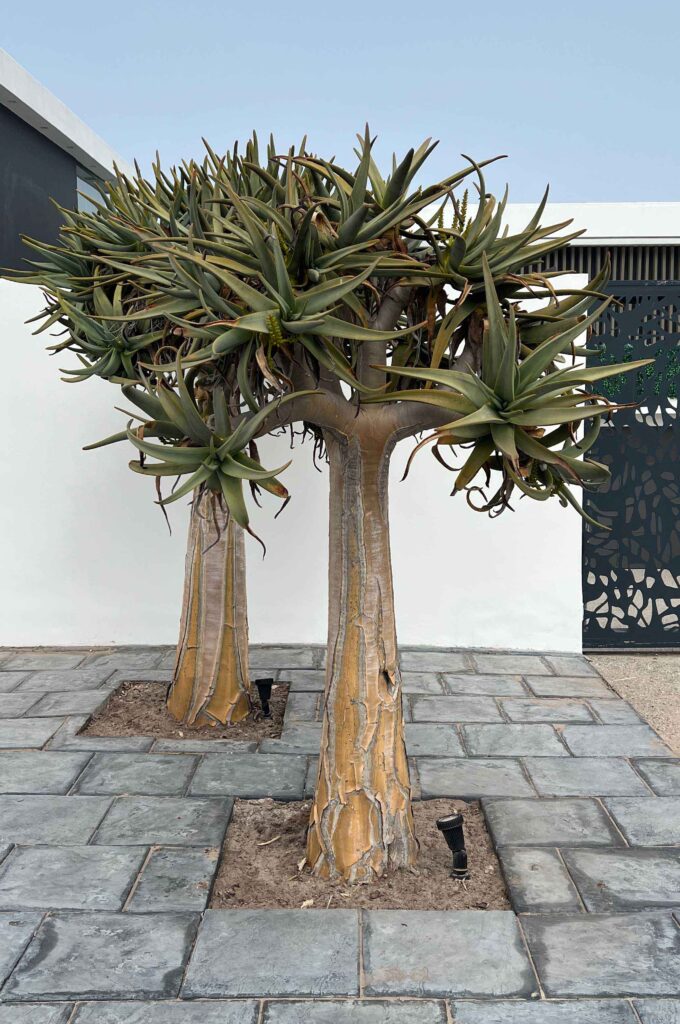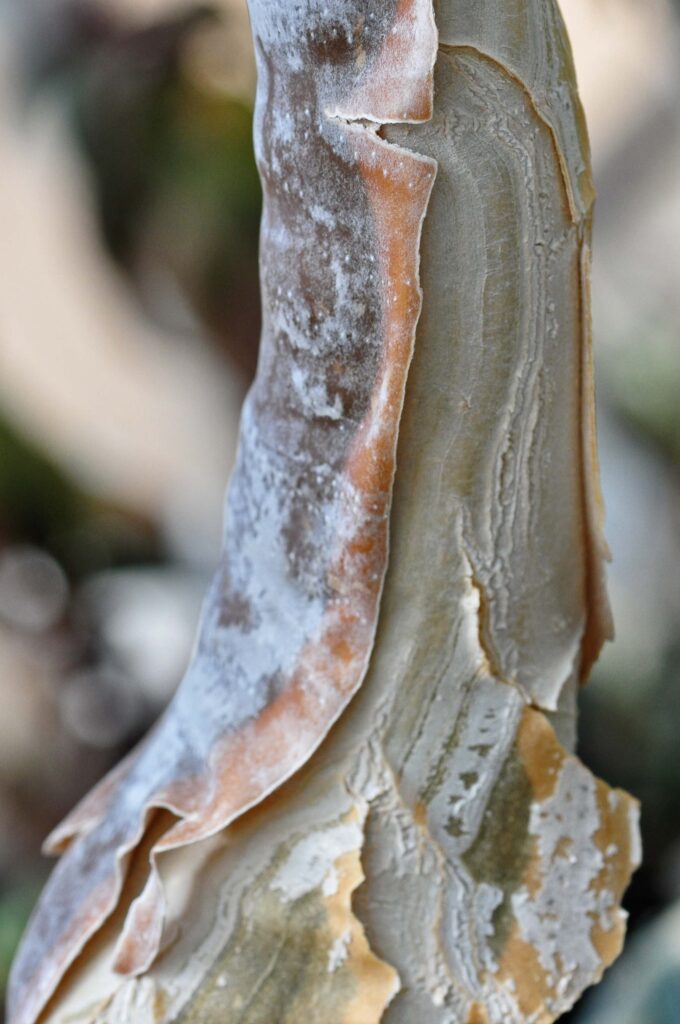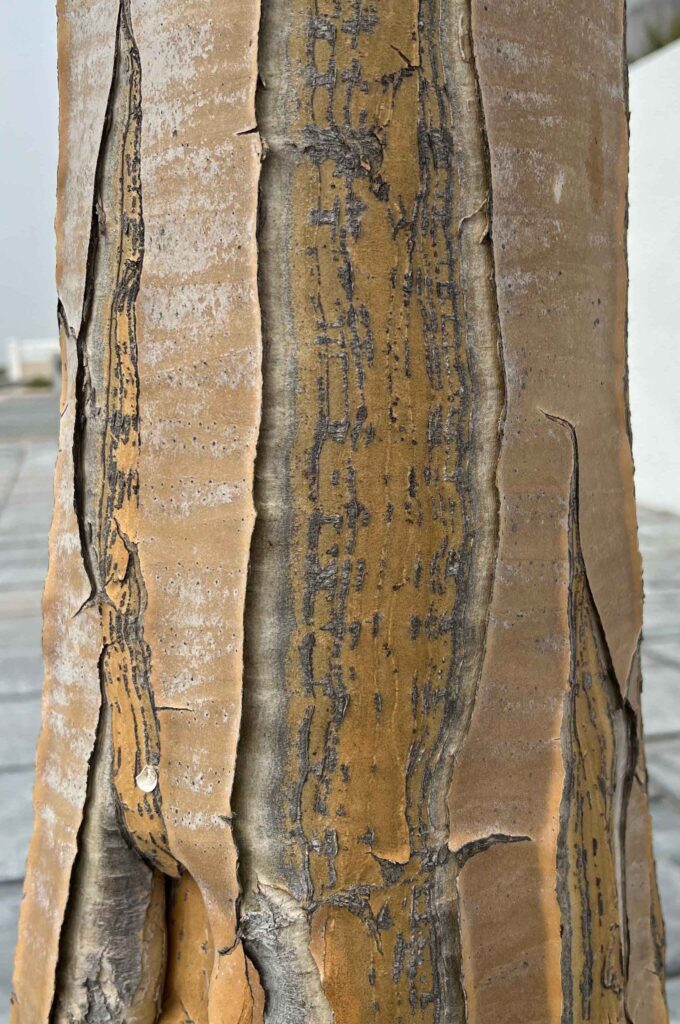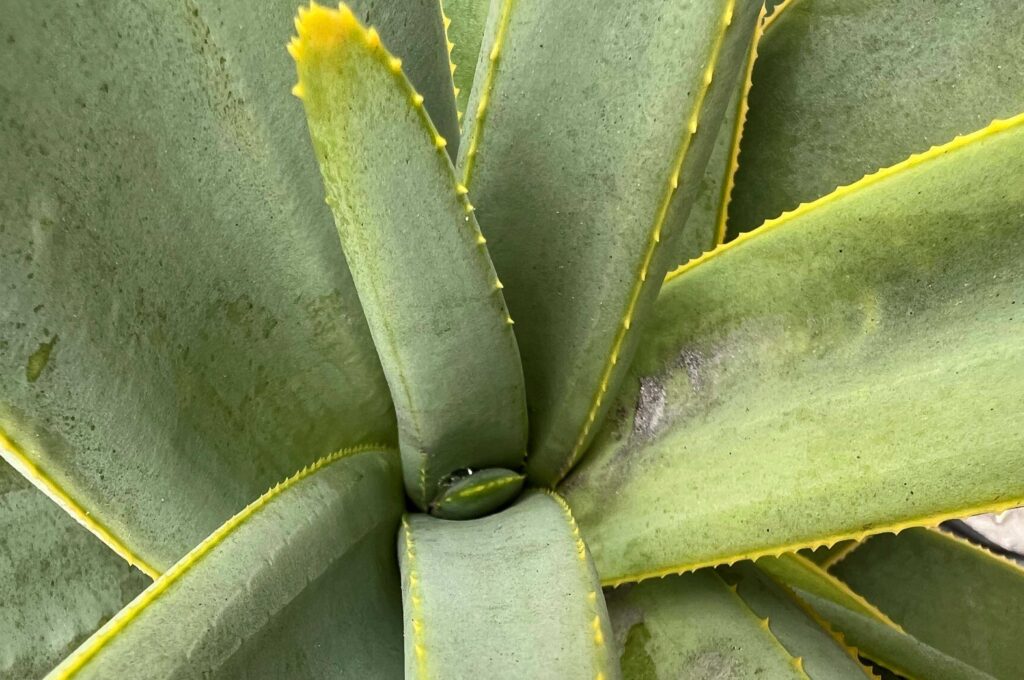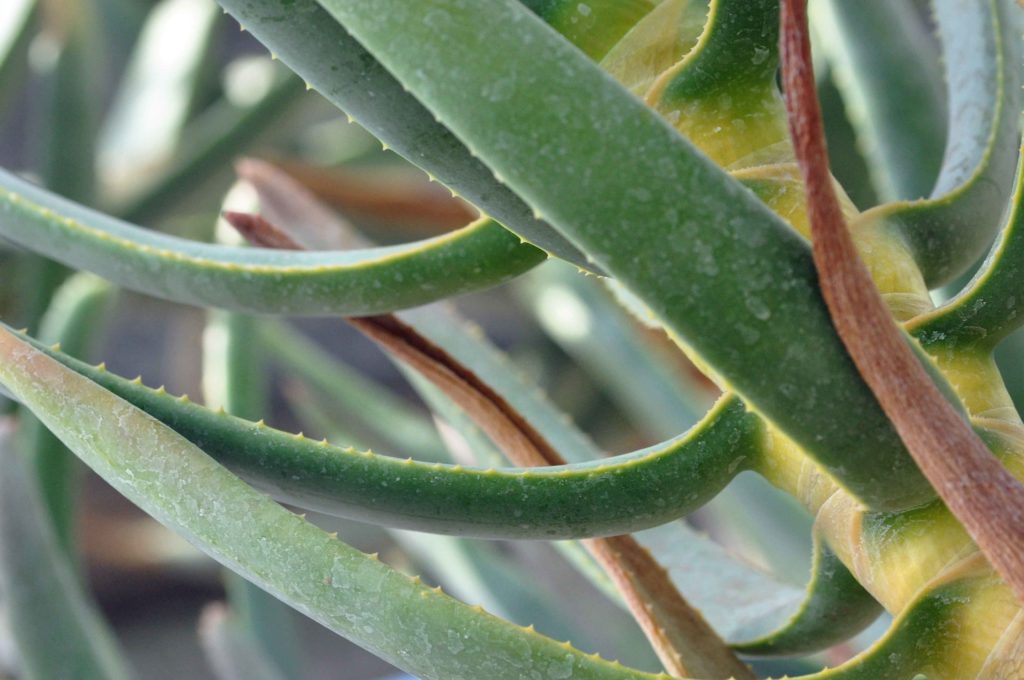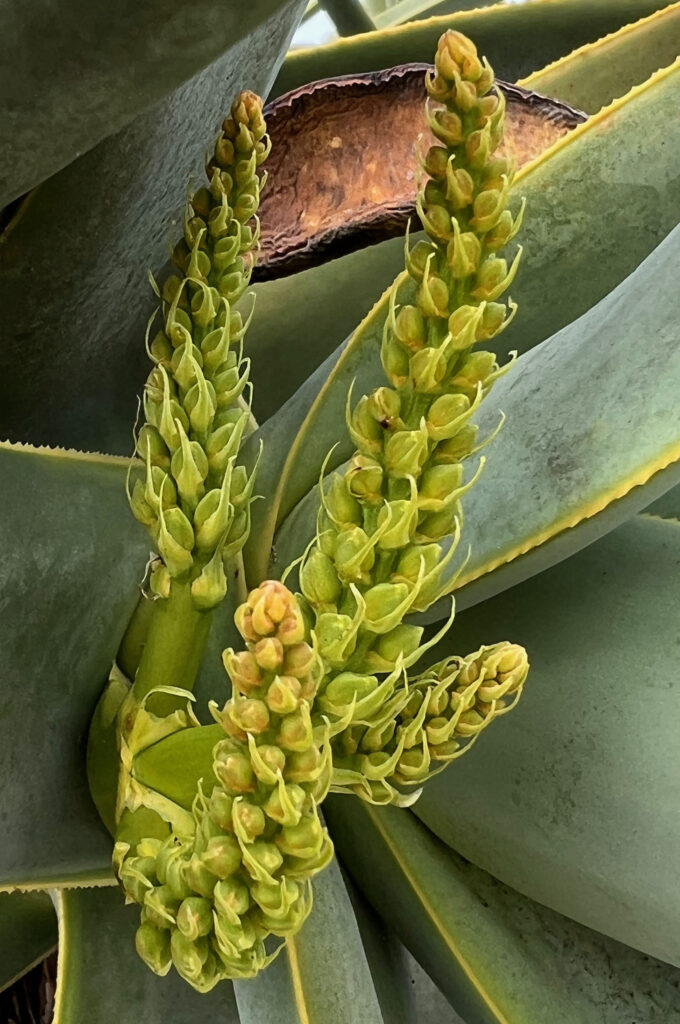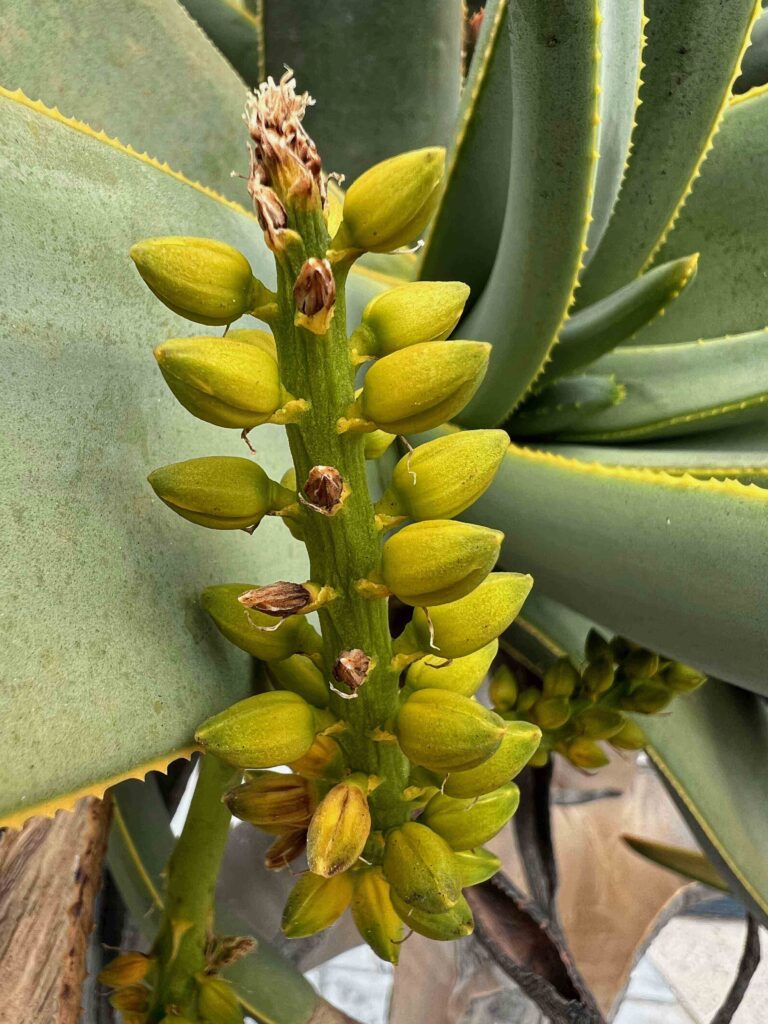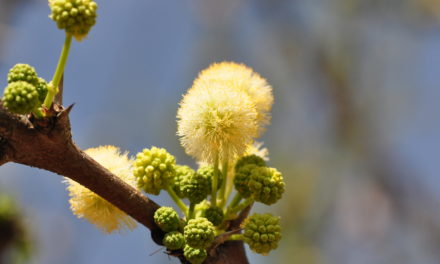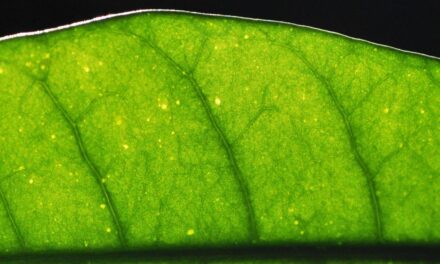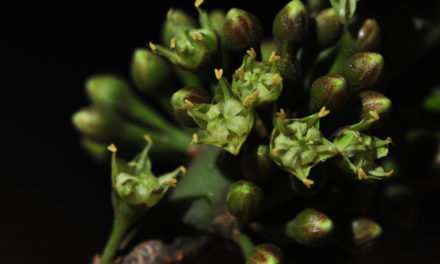Aloidendron dichotomum
General Info – summary
This Tree is up to 7m high with a narrowing trunk. The dense rounded crown has simple spear-shaped Leaves with an amplexicaul base and marginal yellow spines. Terminal, cylindrical, 3-merous Flowers are in racemes. Each has tepals in 2 whorls. 6 exerted stamens have subulate filaments. A superior ovary with a filiform style extends the stigma after anthesis. Fruit is a truncate capsule with winged seeds.
Description
Previous Names: Aloe dichotoma, Aloe dichotoma var. montana, Aloe montana, Aloe ramosa, Rhipidodendron dichotomum, Rhipidodendrum dichotomum.
SA Tree No. 29.
Common names: (Afr) Kokerboom. (Bushman) Choje. (Eng) Quiver Tree. Bushmen used the soft Branches to make quivers for holding their arrows. This is where the common name “Quiver Tree” originated.
Family Asphodelaceae: (Aloe Family). Presumably derived from Asphodel Meadows, which is a section of the Ancient Greek underworld where indifferent and ordinary souls were sent to live after death. The family has about 40 genera and 900 species. There are 10 genera in South Africa. This is a small but widespread, mainly African family of perennial plants. All have Anthraquinones (an aromatic, organic compound, which is the main active constituents of herbs – often used to relieve constipation and may possess antifungal and antiviral properties. They are also widely used in dyes). When present, the Stems are fibrous and woody. The fleshy Leaves often have spines either on the margins or on the blades. The outer 2 flower whorls (the Perianth) lack the classic distinction between calyx and corolla and the lobes are called Tepals. These 2 whorls each have 3 tepals. Flowers are usually borne on a leafless stalk arising from the rosette of leaves. Individual flowers are regular. The 6 Stamens are inserted in 2 whorls of 3, below the superior 3 locular Ovary. Fruit is usually a dry Capsule. Genera with trees on this website include Aloe, Aloidendron and Kumara.
The name Aloidendron or ‘tree aloe’ dates to 2013 and is thanks to molecular studies that are rather shaking up phylogenies and thus classifications. The rambling aloes have also been put in their own genus: Aloiampelos. About 20 of these are considered to be trees.
Name derivation: Aloidendron – aloe (bitter sap) + dendron (tree-like). The name Aloidendron or ‘tree aloe’ dates to 2013 and is thanks to molecular studies that are rather shaking up phylogenies and thus classifications. This is unlike the rambling aloes with their slender stems that are in their own genus: Aloiampelos. dichotomum – Greek – cutting in 2. This refers to the stems repeatedly forked branching. The name Aloidendron or ‘tree aloe’ (about 20 species) dates to 2013 and is thanks to molecular studies that are rather shaking up phylogenies and thus classifications. Aloidendron dichotomum was first brought to world attention by the Simon van der Stel expedition to Namaqualand on the 16 October 1685. This was one of the earliest trees in the interior to be sketched and recorded. The Orange Mouth divides this 400 000+sq km of arid Namaqualand, into land to the North – in Namibia and that in the South into the Northern Cape.
Conservation: National Status: V. Vulnerable. Assessment: 2018 (W. Fodden). Threats include plant stealing, climate change, consumption by domestic livestock and damage by baboons, scale insects and fungi.
Tree
This impressive Tree may reach 7m high but is usually 5m or less. The Stem (main axis of the plant, the leaf and flower bearing as distinguished from the root-bearing axis) is relatively massive with a diameter that may reach nearly 1m wide near ground level. This spongy, thickset rounded Trunk distinctly tapers upwards towards the paired branches (photo 7749). The Stem grows upwards to about half the final length of the tree. Here it divides into 2 branches, and these again divide into 2 stems – and so on (photo 165). The Crown is often rounded (photo 7749). The Bark is initially smooth and whitish or yellowish grey and has splits or streaks (photos 166 and 7755). These splits have scales with sharp edges. The bark may peel off in large patches and is frequently folded (photo 166). On the branches, the bark is pearly grey. The light colour and powdery nature of the bark helps protect the plant from the intense heat of the sun. Bushmen who stored food in hollowed out dead tree trunks made use of this feature. Spreading fibrous Roots help anchor the tree to the ground.
- 7749. 2023/04/02 Yzerfontein (W Cape). Photo B Bezuidenhout. (W Cape).
- 165R. 2019/10/03. Emmarentia. Photo: David Becking.
- 166. 2019/10/03. Emmarentia. Photo: David Becking.
- 7755. 2023/04/02 Yzerfontein (W Cape). Photo B Bezuidenhout.
Leaves
Juvenile plants have leaves ranked in vertical rows (photo 165 under Tree), but as the leaves mature, leaf rosettes gradually develop (photo 7756). The dense rounded crown contains relatively small rosettes of succulent Leaves that are simple (have a single blade, which may have incisions that are not deep enough to divide the leaf into leaflets). The yellowish green to bluish green, spear-shaped leaves (photo 7749 – under Tree) are up to 35 x 5cm and are entire (with a continuous margin, not in any way indented). These leaves occur at branch ends (photo 7749 under Tree). The small yellowish Spines only occur on the leaf Margins (photo 7756). The Petiole (leaf stalk) is absent, and the leaf base is amplexicaul (having an enlarged base that encircles the stem). Old leaves do not remain on the tree.
- 7756. 2023/04/02 Yzerfontein. Photo B Bezuidenhout. (W Cape)
- 168. 2019/10/03. Emmarentia. Photo: David Becking.
Flowers
The cylindrical Flowers with a slightly swollen base occur terminally above the leaf rosette (photo 7753). The monoecious (having both male and female reproductive organs on the same plant) flowers are bright yellow and borne in erect Racemes (a simple elongated inflorescence with stalked flowers that open in succession towards the apex – photo 7753). These racemes are about 30cm high and develop from a 2-5 branched Panicle (indeterminate, branched inflorescence with stalked flowers – photo 7750). In the individual 3-merous (parts in threes) flowers, the Calyx and Corolla are very similar and referred to as the Tepals (with 3 outer and 3 inner segments. The tepals surround the bud (photo 7750). The Stamen Filaments are subulate (a part that is slender and tapering to a point). The superior Ovary contains many ovules, and the filiform (thread or filament like) Style has a minute capitate Stigma that becomes well exserted (sticking out) after anthesis (the period or act of expansion in flowers, especially the maturing of the stamens). A flower is fully open and functional during this period. Anthesis may also refer to the onset of that period). (June-July/Aug).
- 7753. 2023/04/02 Yzerfontein (W Cape). Photo B Bezuidenhout.
- 7758. 2023/04/02 Yzerfontein (W Cape). Photo B Bezuidenhout.
- 7750. 2023/04/02 Yzerfontein (W Cape). Photo B Bezuidenhout.
Fruit
Fertilized ovules develop into winged Seeds within an erect cylindrical and apically truncate (appearing as if cut of at the end) Capsule (a dry fruit resulting from the maturing of a compound ovary which usually opens at maturity by one or more lines of dehiscence). This capsule becomes woody when dry.
Distribution & Ecology
This succulent tree is endemic in southern Africa (Endemism is the ecological state of a species being unique to a defined geographic location). This tree does not survive in cold, wet areas. It grows in the desert and semi-desert of Namibia – at least as far north as Walvis Bay and also grows in the Northern Cape of South Africa, as well as to the east – as far as the Upington area. These plants mainly grow on very dry rocky ridges. This plant can survive temperatures as high as 43 degrees C. To the north, plants tend to occur on the southern slopes and to the south they tend to grow on slopes facing north (temperature adjustment). Trees also occur close to the sea. An unusual group of these trees occurs near the Orange River between Pofadder and Pella and there is another near Keetmanshoop in southern Namibia. The tree can be seen at the Karoo Desert National Botanical Garden in the town of Worcester (located 120km northeast of Cape Town). The flowers produce quantities of nectar, and this attracts animals including insects, birds and baboons. The baboons tear the flowers apart to gain access to the nectar. The tree is a favourite nesting place for sociable weavers (Philetairus socius) which have roughly the same distribution as this tree. Their nests get very big and may partly cover the tree. The multi-chambered nests they build may become huge – enclosing successive generations of sociable weavers. Pied Barbets (Tricholaema leucomelas) with a black and white striped head normally occur in dry bushy areas and make their nests in holes dug into the stems of this tree. Bees collect nectar and are at least partly responsible for pollination. These trees have been planted near Augrabies Falls. Climate change is contributing to the decline of species.
Ethnobotany
This plant was grown in Kew Gardens in the UK over 200 years ago! Flower buds are edible. Before planting, expose seeds to direct sunlight. Plant the seeds in pure sand. Bone meal introduced into the soil will help root development. Good drainage is essential, and this can be enhanced by planting the seedlings on a slope where there is all day direct sunlight. Water very sparingly – mainly in the growing season. The plants grow quickly but are frost sensitive. Cuttings should be thoroughly dried for several days in a shaded area before planting. In suitable places, these trees are now being quite widely grown for decoration. These plants may survive for 80 years. They do best away from cold and damp places. Local medicine makes use of parts of the tree. Control of sap-sucking insect like aphids may be necessary.
References
Coates Palgrave, M. 2002. Keith Coates Palgrave Trees of Southern Africa, edn 3. Struik, Cape Town.
Foden, W., Raimondo, D., Eastment, C., Grey, K.-A, Geldenhuys, C.J., Van Wyk, P.C.V., Jurgens, N., Hoffman, M.T., Swart, E., Midgley, G. & Jacobs, P. 2022. Aloidendron dichotomum (Masson) Klopper & Gideon.F.Sm. National Assessment: Red List of South African Plants version . Accessed on 2025/03/01.
Ginn P.J. Mcilleron W.G. and Milstein P. le S, 1989. The Complete Book of Southern African Birds. Struik, Cape Town.
Palmer, E. & Pitman, N. 1972. Trees of southern Africa. Balkema, Amsterdam, Cape Town.
van Wyk, B. & van Wyk, P. 1997 Field guide to Trees of Southern Africa. Struik, Cape Town.
https://en.wikipedia.org/wiki/Sugarbird
http://plantsoftheworldonline.org/taxon/urn:lsid:ipni.org:names:77125490-1
https://operationwildflower.org.za/index.php/albums/habitat/semi-desert/aloe-dichotoma-judd-1-2883
http://pza.sanbi.org/aloidendron-dichotomum
http://posa.sanbi.org/flora/browse.php?src=SP

